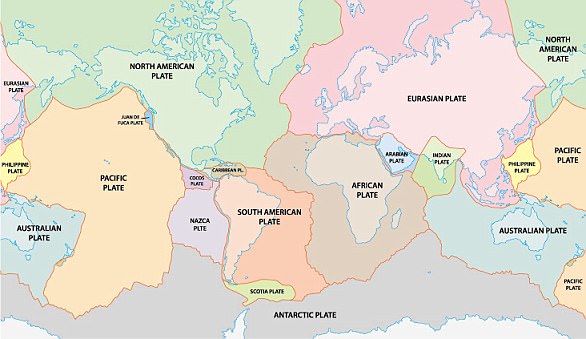Scientists are baffled after discovering Earth's inner core is DEFORMED
From a land of dinosaurs to a secret military base, science fiction has speculated wildly about what might be hiding at the centre of the Earth.
Now, a study suggests that our planet's innermost depths could be even stranger than anyone had thought.
Until now, it was widely believed that the inner core was a dense ball of iron floating at the centre of the molten outer core.
However, scientists have been baffled to discover that the inner core is actually changing shape.
By looking at the shockwaves from earthquakes, researchers found evidence that the core is changing shape and shifting at the edges.
'The molten outer core is widely known to be turbulent, but its turbulence had not been observed to disrupt its neighbour the inner core on a human timescale,' said lead author Professor John Vidale, of the University of Southern California.
'What we're observing in this study for the first time is likely the outer core disturbing the inner core.'
This revelation may shed light on the mystery of why the inner core's rotation appears to have been slowing down over recent years.

Scientists previously believed the Earth's inner core was a solid ball of molten iron and nickel. But now, a new study suggests that it might not be a solid after all
While scientists obviously can't travel down to study these layers directly, they are able to learn about them by carefully recording earthquakes around the world.
When the shockwaves from an earthquake pass through something dense, they are delayed or refracted, just like when a beam of light passes from air to water.
By analysing hundreds of shockwaves, scientists can build up a model for the Earth's structure that would explain why the seismic data looks the way it does.
The most useful type of seismic activity for this purpose is tremors which occur at the exact same place at different times, called repeat earthquakes.
Since the waves from repeat earthquakes all start in the exact same position, if they look different something must have changed in the planet's inner structure.
Using this technique, researchers have discovered that the inner core's rotation is not constant.
In fact, the inner core's rotation completely changed direction in 2010 and has been slowly moving in the opposite direction since.

Researchers analysed 168 pairs of repeat earthquakes in Antarctica which had been recorded by research stations in Canada and Alaska. By looking at how the earthquakes changed as they passed through the planet, the researchers built up a model of the planet's structure
It was actually this change in rotation which Professor Vidale had set out to study when he made his shocking discovery.
The researchers gathered 168 pairs of repeating earthquakes from 42 locations around Antarctica's South Sandwich Islands between 1991 and 2024.
These were paired with the waveforms which arrived at seismic receivers located in Fairbanks, Alaska and Yellowknife, Canada.
While the Alaskan data looked like the researchers expected, the seismic data from the Yellowknife station had some strange properties that had never been seen before.
Professor Vidale says: 'As I was analysing multiple decades' worth of seismograms, one dataset of seismic waves curiously stood out from the rest.
'Later on, I'd realize I was staring at evidence the inner core is not solid.'
Using earlier models of the inner core's rotation, Professor Vidale realised that the seismic waves from repeat earthquakes looked different even when the core was supposed to have been in the same position.
Curiously, this was only the case for waves which grazed the edge of the inner core, while waves that passed straight through were unaffected.

The researchers found that waves which skimmed the edge of the inner core (left) produced different results even when the core was in the same location, while waves which passed through (right) were unaffected. This suggests that the edge of the inner core may be changing shape

The inner core might be changing shape where the turbulent outer core meets its nearly molten edges. These changes could help scientists understand why the inner core changes its rotation, and what effect this will have on the planet (stock image)
The best way to explain this change was that the surface of the inner core was changing shape over time and deflecting waves which skimmed its surface.
Professor Vidale says: 'What we ended up discovering is evidence that the near surface of Earth's inner core undergoes structural change.'
This is likely due to the contact between the rapid movement of the liquid outer core and the very-near-melting surface of the inner core.
These convection currents and powerful magnetic forces cause the edge of the inner core to undergo 'viscous deformation', a type of change found in very thick liquids like honey.
As the inner core spins, its magnetic field and gravitational influence pull on the planet's outer layers.
When this rotation changes, it can create forces strong enough to alter the Earth's rotation and make the days slightly longer.
While previous research suggested that the inner core's rotation was fairly consistent, there is now a growing body of evidence which shows it could be far more dynamic.
If the inner core really does change shape over time, this might help us understand why its rotation changes so much and what kinds of effects this could have on the rest of the planet.
























































































































































 Gang-bang 'factory' with sex disco where 'several men' pay £60 each to join group session with one woman sparks uproar in Paris district as neighbours say it encourages gang rape
Gang-bang 'factory' with sex disco where 'several men' pay £60 each to join group session with one woman sparks uproar in Paris district as neighbours say it encourages gang rape